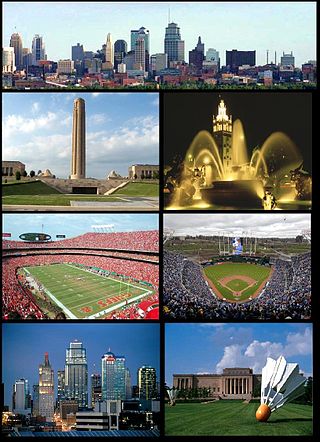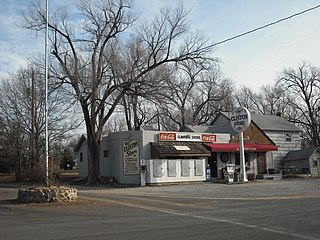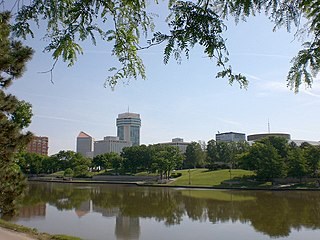
Douglas County is a county located in the U.S. state of Kansas. Its county seat and most populous city is Lawrence. As of the 2020 census, the county population was 118,785, making it the fifth-most populous county in Kansas. The county was named after Stephen Douglas, a U.S. Senator from Illinois and advocate for the popular sovereignty choice in the Kansas slavery debate.

Lawrence is a city in and the county seat of Douglas County, Kansas, United States, and the sixth-largest city in the state. It is in the northeastern sector of the state, astride Interstate 70, between the Kansas and Wakarusa Rivers. As of the 2020 census, the population of the city was 94,934. Lawrence is a college town and the home to both the University of Kansas and Haskell Indian Nations University.

Lecompton is a city in Douglas County, Kansas, United States. As of the 2020 census, the population of the city was 588. Lecompton, located on the Kansas River, was the de jure territorial capital of Kansas from 1855 to 1861, and the Douglas County seat from 1855 to 1858. Anti-slavery Lawrence became the de facto capital during the latter part of this period, when the county seat was moved there. This time period was known as Bleeding Kansas, due to the violence perpetrated by the pro-slavery, and to a lesser extent the anti-slavery, factions in the eastern part of the state. Lecompton was a hotbed of pro-slavery sentiment during the mid-1800s.

The University of Kansas (KU) is a public research university with its main campus in Lawrence, Kansas, United States. Two branch campuses are in the Kansas City metropolitan area on the Kansas side: the university's medical school and hospital in Kansas City, Kansas, the Edwards Campus in Overland Park. There are also educational and research sites in Garden City, Hays, Leavenworth, Parsons, and Topeka, an agricultural education center in rural north Douglas County, and branches of the medical school in Salina and Wichita. The university is a member of the Association of American Universities and is classified among "R1: Doctoral Universities – Very high research activity".

The Kansas City metropolitan area is a bi-state metropolitan area anchored by Kansas City, Missouri. Its 14 counties straddle the border between the U.S. states of Missouri and Kansas. With 8,472 square miles (21,940 km2) and a population of more than 2.2 million people, it is the second-largest metropolitan area centered in Missouri and is the largest metropolitan area in Kansas, though Wichita is the largest metropolitan area centered in Kansas. Alongside Kansas City, Missouri, these are the suburbs with populations above 100,000: Overland Park, Kansas; Kansas City, Kansas; Olathe, Kansas; Independence, Missouri; and Lee's Summit, Missouri.

Vinland is an unincorporated community in Douglas County, Kansas, United States. It is located south of Lawrence and north of Baldwin City.

The University of Kansas Natural History Museum is part of the University of Kansas Biodiversity Institute, a KU designated research center dedicated to the study of the life of the planet.
The Ohio College of Dental Surgery opened in 1845 in Cincinnati, Ohio, becoming the second private dental college in the world. In 1866 Lucy Hobbs Taylor graduated from this college, making her the first woman to graduate from any dental college. The college affiliated itself with the University of Cincinnati in 1887, but it was ultimately closed in 1926.

Clinton is an unincorporated community on a peninsula next to Clinton Lake in Douglas County, Kansas, United States.

Massachusetts Street is the main street that runs through the central business district of downtown Lawrence, Kansas. It begins just south of the Kansas River at Sixth Street and continues south until reaching Haskell Indian Nations University. The street was given its name by members of the New England Emigrant Aid Company, most of whom were from the state of Massachusetts. In 2014, Mass Street was named the most popular tourist attraction in Kansas by TripAdvisor.

The Kansas Aviation Museum is a museum located in Wichita, Kansas, United States, near 31st South and George Washington Blvd. The building, designed by Glen H. Thomas, was the former Wichita Municipal Airport terminal from 1935 to 1954. In February of 2024, the Wichita City Council approved an honorary over-naming of George Washington Blvd. as "Air Capital Blvd", recognizing the impact that Wichita makes in aviation.
A Mississippi Landmark is a building officially nominated by the Mississippi Department of Archives and History and approved by each county's chancery clerk. The Mississippi Landmark designation is the highest form of recognition bestowed on properties by the state of Mississippi, and designated properties are protected from changes that may alter the property's historic character. Currently there are 890 designated landmarks in the state. Mississippi Landmarks are spread out between eighty-one of Mississippi's eighty-two counties; only Issaquena County has no such landmarks.

The history of the University of Kansas can be traced back to 1855, when efforts were begun to establish a "University of the Territory of Kansas." Nine years later in 1864, together with the help of Amos Adams Lawrence, former Kansas Governor Charles L. Robinson, and several other prominent figures, the Kansas Legislature chartered the University of Kansas in Lawrence, Kansas. The university was initially funded by a $15,000 endowment on a 40-acre (160,000 m2) allotment of land from Charles Robinson and his wife Sara. The university commenced preparatory-level classes in 1866 and college-level classes in 1869.

The Museum of Gloucester in Brunswick Road is the main museum in the city of Gloucester, England. It was extensively renovated following a large National Heritage Lottery Fund grant, and reopened on Gloucester Day, 3 September 2011.

Delano is a neighborhood located in Wichita, Kansas, United States. A mixed commercial and residential area on the west bank of the Arkansas River, it is home to Friends University, Riverfront Stadium, and Exploration Place, the Sedgwick County science museum.

Lawrence's Downtown Historic District comprises the commercial core of Lawrence, Kansas. The district comprises areas along Massachusetts Street between 6th Street and South Park Street. Nearly all of the contributing structures are masonry commercial buildings, typically with display windows at street level and smaller windows at upper levels. Four properties are individually listed on the National Register of Historic Places: Old Lawrence City Hall, the old Douglas County Courthouse, the Eldridge House Hotel, and the US Post Office-Lawrence. The district includes a total of 136 resources, 99 of which are considered to contribute to the district.
The following is a timeline of the history of the city of Wichita, Kansas, USA.

Downtown Wichita is the central business district, government and social core of the Wichita metropolitan area, in the U.S. state of Kansas. It is home to several of the area's major landmarks and event venues including the Epic Center, Century II Performing Arts & Convention Center, Intrust Bank Arena, Riverfront Stadium, Keeper of the Plains sculpture, the Old Town entertainment district, and the historic Delano neighborhood.
Elizabeth Josephine Watkins (1861-1939) was a philanthropist, best known for funding hospitals and scholarship halls in Lawrence, Kansas.
















